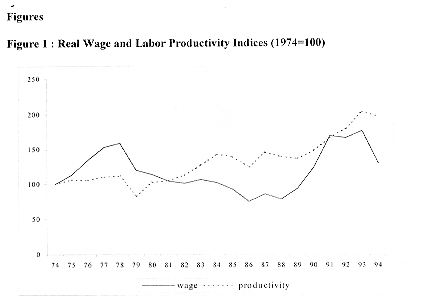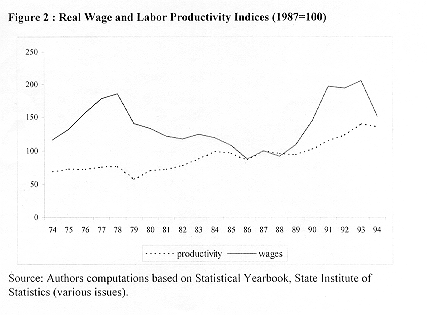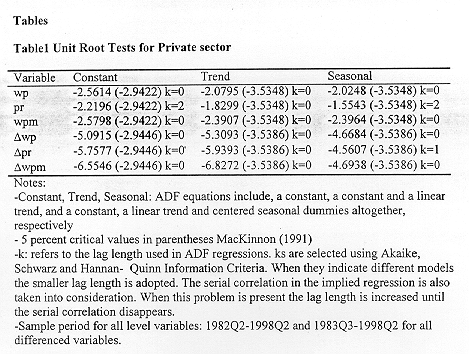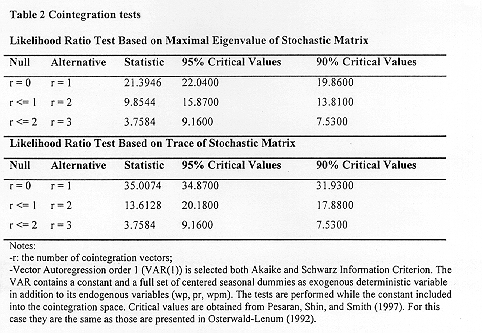
ARE REAL WAGES AND COMPETITIVENESS COMPATIBLE IN THE TURKISH MANUFACTURING INDUSTRY?
Hasan Kirmanoglu, Istanbul Bilgi University, Turkey, E-mail:
hkirman@ibun.edu.tr
M. Ege Yazgan*, University of Sussex, UK and University
of Istanbul, Turkey. E-mail: M.E.Yazgan@sussex.ac.uk
Abstract
In developed countries there generally exists a positive correlation between real wages and labor productivity. However, data from the Turkish manufacturing industry indicates the absence of such a correlation in the Turkish economy. The implication is that nominal wages are being used as an instrument for populist policies in Turkey, leading to a trade-off between real wages and competitiveness, as found in the analysis of Dornbusch and Edwards (1993). During populist periods, real wages increase at a higher rate than labor productivity. It follows that the resulting loss of competitiveness leads to a deterioration of the balance of payments and therefore contributes to economic crises in Turkey. In our study we empirically estimate labor productivity elasticities of real wages for both the public and private sectors of the Turkish manufacturing industry, using various cointegration techniques. Our econometric model is a modified version of Collins and Park (1989) that specifies the relationship between real wages, labor productivity, and competitiveness. We generate estimations using quarterly data, ranging on a ten-year period: 1988Q1-1998Q2. Our empirical findings strongly indicate that: (1) in the private sector, labor productivity elasticity of real wages is very low so that there is an obvious trade-off between competitiveness and real wages determination, (2) in the public sector, real wages are inelastic to labor productivity so that competitiveness and real wages are perfectly incompatible.
Keywords: Wages, Productivity, Competitiveness, Cointegration
JEL
Classifications: C33, D33, E6
1. Introduction
The aim of this article is to test empirically the following hypothesis: In the Turkish economy, real wages are inelastic with respect to labor productivity, leading to a trade-off between real wage determination and competitiveness. Figure1 reflects the observation on which this hypothesis is based. It shows the evolution of real wages and labor productivity in total manufacturing industry relative to the base year of 1974. As can be seen from the graph, the increase in real wages is greater than that in labor productivity up to 1978 while the level of real wages remains above labor productivity until 1981. Real wages cease to increase in 1978, corresponding with the beginning of a severe economic crisis. The downward turn in real wages continues up to 1988. 1989 is the starting year of the populist policies as reflected in sharp increases in real wages that terminated with 1994 crisis.

Figure 2 is constructed by taking 1987 as the base year and exhibits the same dynamic in reference to a year in which the level of real wages is less than that of 1974. In the 1974-1986 period, real wages are higher than labor productivity. In this period (1974-1986) the increase in real wages exceeds that in labor productivity. This trend is reversed in the 1979-1988 period. The populism implemented after 1989, especially in the period 1989-1993, can be clearly seen from Figure 2. As the figure shows, 1989 is the starting year of significant real wage increases.

From the two figures we can discern three different periods: 1974-1978, 1979-1988, and 1989-1993. The first and the third periods are the periods where the populist economic policies are implemented. Their main feature is the excess of increases in real wages vis-à-vis increases in labor productivity. The second period is the adjustment period that reverses the course of the populist policies in that the increase in labor productivity is above the increase in real wages.
This observation indicates the lack of co-movements in real wages and labor productivity. Moreover, this lack of co-movements which does not exist in developed countries1 leads us to think that wages tend to be used as an instrument for populist policies2 and a situation in which a trade-off between competitiveness and real wages, as put by Dornbusch and Edwards (1993) as the dilemma of populism, prevails for Turkey as well.3 As result of this trade-off during populist periods real wages increase much above labor productivity -which reflect the basic sign of populist policies- accompanied by the loss of competitiveness which leads to a deterioration in the balance of payments, that in turn is one of the basic causes of economic crises in Turkish economic history.
Taking this lack of co-movements between real wages and labor productivity as the basis for the analysis of the populist policies completes the analysis developed by Dornbusch and Edwards (1993). In their model that analyzes the populist policies implemented in Allende's Chile and in Garcia's Peru, the authors defined the common thread of populist policies as "reactivation with distribution", (i.e., high growth of output, high real wages, and high employment). Their model "...shows that real wages can be raised either by real appreciation (i.e. real exchange rate overvaluation) or by subsidies. But real appreciation interferes with the external constraint and subsidies are inflationary." On the other hand, "...employment can be expanded by subsidies or by real depreciation. The former is inflationary and the latter hurts real wages. The room for policies that raise real wages and employment is therefore severely limited." According to the authors, as long as foreign exchange is available "the trade-offs are not apparent, but once the reserves run out the trade-offs will suddenly, and cruelly, appear: inflation will then rapidly accelerate."
Although we accept this analysis, we think that the trade-off between real wages and real exchange rate overvaluation needs to be treated more explicitly. In Dornbusch and Edwards's model, labor productivity is not taken into consideration. However, according to Collins and Park (1989), "...productivity growth can eliminate the sharp conflict between these two objectives (i.e., competitiveness and standard of living, Kirmanoglu-Yazgan) by creating a cushion. Real wages may rise while the real exchange depreciates (and unit labor costs in foreign currency falls), and as long as productivity is growing strongly enough. The condition for this scenario is that nominal wage growth exceed the domestic inflation but not the sum of nominal depreciation and productivity growth." Hence, for the trade-off between real wages and real exchange rate overvaluation to be true, the increase in real wages must exceed that in productivity.
The first part of the article develops a model that is a modified version of Collins and Park (1989) and specifies the relationship between real wages, labor productivity and competitiveness. The second part is devoted to the empirical test of our hypothesis through this model.
2. The Model
The variables of the model are as follows: WP: real product wage, x : measure of competitiveness, W: nominal wage, E: nominal exchange rate (TL/$), Px: export price index, Pm: import price index, P: manufacturing producer price index, PR: labor productivity.
Equation (1) denotes real product wage while equation (2) denotes unit labor cost of manufacturing output measured in foreign currency, which is a measure of competitiveness. The ratio represented by equation (2) and competitiveness are inversely related; the lower the ratio, the stronger the competitiveness.
(1) WP = (W / P)
(2) x = [W / (E.PR)]
To highlight the role of labor productivity in determining the behavior of these two variables, we assume a very simple price setting mechanism. Turkey is assumed to take the price of imported goods as given. Export prices are assumed to be determined by costs. Manufacturing output is produced using labor and imported intermediates:
(3) Px = (W / PR)a . (E . Pm)b, a + b = 1
Equation (4) defines the manufacturing producer price index as a weighted average of import and export price indices:
(4) P = (E . Pm)a . (Px)b, a + b = 1
Substituting (3)-(4) into equation (1) enables us to rewrite the real wage in terms of labor productivity, nominal wages, the nominal exchange rate, and the world price of imports:
(5) WP = [W / (E . Pm)]1-aa . PRaa
Equation (5) indicates that the real wage increases when labor productivity rises; when nominal wages rise relative to the domestic price of imported intermediates; or when the nominal exchange rate appreciates. However, the rise in nominal wages and/or the nominal exchange rate appreciations endanger competitiveness (see (eq.2)). Putting it differently, there is a trade-off between competitiveness and real wages as long as the increase in real wages result from the rise in nominal wages and/or the nominal exchange rate appreciations. But, equation (5) also shows that labor productivity can eliminate this trade-off by creating a cushion. The success of this elimination depends on the magnitude of the elasticity of real wages to the labor productivity, aa . At the one extreme case when this elasticity is equal to 1 the trade-off between real wages and competitiveness disappears completely. We may characterize this case as "perfect compatibility" between real wages and competitiveness. However, at the other extreme case when aa = 0, this trade-off is complete [the elasticity of (nominal wages/domestic price of imported intermediates), 1-aa = 1]. We may characterize this case as "perfect incompatibility". For our hypothesis to be true aa must be very low, if not zero. Putting it differently, in the Turkish manufacturing industry case, we hypothesize that the compatibility between competitiveness and real wages is far from being perfect.
3. Empirical Analysis
In this section we estimate the log linear form of equation (5) allowing a constant in our equation as well.
(6) wp = bo + b1 wpm + b2.pr
where wp = ln(W / P), wpm = ln[w / (e . Pm)], pr = lnPR, b1 = (1 - aa ), and b2 = aa . Equation (6) is estimated in its dynamic form allowing four lags for each variable, as explained below.
3.A. Data: Sources and Time Series Properties
Quarterly data covering the period 1988Q1 1988Q2 (42 observations in all) were used in estimation. All series were obtained from the State Planning Organization (SPO) of Turkey.4 The variables and their descriptions are as follows:
wp: Real wages in private manufacturing sector i.e. average hourly earnings divided by production index;
pr: Labor productivity in private manufacturing sector defined as output per worker. Where output is the private manufacturing production index;
wpm: (nominal wages/domestic price of imported intermediates) in private manufacturing sector. Where, w: average hourly earnings, pm: nominal exchange rate (TL/$) times import price index ($).
Table 1 displays the result of Augmented Dickey Fuller (ADF) unit root tests for each of the three variables defined above and their first differences (D ).

The results in Table 1 clearly indicates that all variables are stationary in their first differences (i.e. they are all I(1)). This property brings about the question of the existence of a cointegrating relationship between them.
3.B. Cointegration Analysis
We test the cointegration likelihood ratio tests developed by Johansen (1988, 1991). Table 2 shows the results.

These statistics generally support the hypothesis that there exists single cointegration vector among the three variables.5 We interpret this single cointegration vector as a long run relationship between real wages, productivity, and competitiveness in the form of equation (6). The estimated long run values of coefficients resulting from Johansen's maximum likelihood estimation are compared with three other single equation method suggested in the literature.6 In all cases we obtained the similar values. Below we present the long-run coefficients obtained from the estimation of auto regressive distributive lag version of equation (6) allowing four lags of each variable [ARDL(4,4,4)]. The method is suggested by Pesaran and Shin (1999) and as long as the underlying ARDL model is free of serial correlation (taking the lag structure of the right hand side variables into consideration as well) endogeneity is less a problem.7 Equation (7) displays the coefficients estimates and their standard errors (in parentheses) together with the associated probability values (in brackets).
(7) wp = -5.8060 + 0.39696pr + 0.70242wpm
(0.33971) (0.08567) (0.05871)
[ 0.000 ] [ 0.000 ] [ 0.000 ]
The long run coefficient estimates in equation (7) are all significant at any significance level and their signs and magnitude are compatible with the model outlined above as the sum b1 and b2 is nearly equal to unity (see equation (6) above). These coefficient estimates show the importance of imperfect compatibility between competitiveness and real wages in the Turkish private manufacturing industry. This is indicated by the fact that the coefficient of the pr is highly below unity (0.39696). The coefficient of wpm indicates that, as wpm (nominal wages/domestic price of imported intermediates) increases by 1 percent, real wages go up 0.7 percent approximately.
3.C. Short-run Dynamics
In this section we estimate a short run error correction model by using a "general to specific" type procedure to reduce the error correction form of ARDL(4,4,4) model to its parsimonious form.8 This resulted in the model presented below in equation (8) and involved dropping insignificant variables and reparameterazation.9
(8) D wpt = 0.38576D wpt-2 + 0.19617D 2prt + 0.66249D wpmt - 0.22922D wpmt-2 - 0.58910l t-1
(0.17223) (0.10725) (0.05047) (0.12511) (0.16579)
[ 0.032 ] [ 0.077 ] [ 0.000 ] [ 0.077 ] [ 0.001 ]
Diagnostic Tests
R2 = 0.86825, ![]() = 0.83850, c 2SC(4) =
1.3541 [0.852], c 2FF(1) = 0.9018
[0.342], c 2N(2) = [0.779],
= 0.83850, c 2SC(4) =
1.3541 [0.852], c 2FF(1) = 0.9018
[0.342], c 2N(2) = [0.779],
c 2HE(1) = 0.3299
[0.566]10
D and D 2 are first and second difference operators respectively and l = wp + 5.8060 - 0.39696pr - 0.70242wpm. Equation (8) passes all the diagnostic tests reported above and has a quite high R2 value. Moreover the coefficient of the error correction term, l is found highly significant by using conventional t values and has the "correct" sign. The significance of this coefficient strengthens the result of the cointegration test above.11 On the other hand its magnitude (0.58910) indicates relatively quick adjustment to disequilibrium. The contemporaneous short run effect of wpm is highly significant and has a considerable effect on the growth rate of real wages. On the other hand the coefficient of second lagged changes in wpm is only significant at 10 percent significance level and has the "wrong" sign. However even if this effect is considered significant the total short run effect of wpm remains still positive and considerably big around 0.43 (as the sum of both coefficients). The short run coefficient of labor productivity can only be accepted as significant at 10 percent significance level and indicates a smaller effect than the total short wpm effect. These results show that the empirical evidence remains consistent with the long run results when short run effects are also taken into consideration.
3.D. Public Sector
The empirical evidence from private sector presented above is quite supportive of the hypothesis that in the Turkish economy, real wages and competitiveness are imperfectly compatible. For what seems to be true for private sector should be more obvious for public sector to a greater extent. Since the public sector is source of the implementation of populist wage policies, our prior expectation is to find much lower coefficient for productivity and approach to the complete trade-off (or perfect incompatibility) case mentioned above. However, the time series properties of the data from public sector do not allow us to perform a similar type of analysis, since the ADF tests (not reported here) indicate that the null of unit root for productivity can be rejected in its level versus trend stationarity while the other two variables are found stationary in their first differences only. Hence, we cannot apply Johansen technique to test for cointegration in this mixed case. Assuming the long-run relationship exists and running an ARDL(4,4,4) regression leads to the following long run equation: wp=-4.037+0.08prk+0.8wpm. The coefficient of productivity remains insignificant with a probability value equals 0.480, while wpk is significant with [0.000]. Also, the coefficient of l is equal to -0.5 and remains significant at 5 percent significance level with [0.045] by using conventional critical values if one considers this as an evidence in favor of cointegration (see endnote 11).
However, if we adopt a different path and accept the productivity series in public sector as trend stationary and detrend the series by using the residual from a regression on a linear trend a simple OLS regression of the first difference of real wages on detrended productivity and first difference of wpm leads the following result: D wp = -0.004 + 0.049prd +0.925D wpk (where prd is the detrended productiviy). Again the associated probability value for prd indicates that this variable is insignificant at conventional significance levels with [0.813], while D wpk is significant with [0.000]. Allowing more lags into this equation does not alter this conclusion.
4. Conclusion
Our empirical findings strongly indicate that: (i) in the public sector there is perfect incompatibility between real wages and competitiveness; (ii) in the private sector the compatibility is far from being perfect.
These findings have important implications for the Turkish economic policy-makers. A wage policy based on political considerations irrespective of labor productivity, that leads to increases in nominal wages in the public sector (and by a spill-over effect in the private sector) deteriorates the competitiveness and hence balance of payments.
A better policy will be to relate nominal wages to labor productivity. In this way we can avoid the destructive cycle of populism-crisis-adjustment.
Endnotes
1 Huh and Trehan (1995) provide some empirical evidence for developing countries.
2 We assume a spill-over effect from public wages to private wages. Considering the size of public sector in Turkish economy this seems to be a reasonable assumption.
3 Dornbusch and Edwards do not consider the role of productivity in this mechanism.
4 The data and all the detailed estimation results are available upon request.
5 In the light of the Monte Carlo evidence presented in Cheung and Lai (1993) our preference is to use the trace statistic for inference which rejects the null of no cointegration at 5 percent significance level. According to Cheung and Lai's results, in small samples the cointegration tests based on the trace statistic tend to be more robust as compared to the tests based on the maximum eigenvalue statistic which rejects the null of no cointegration at 10 percent significance level only.
6 We tried to estimate the long-run coefficients by using the following methods. Static OLS (Engle and Granger, 1987), fully modified OLS (Phillips and Hansen, 1990), autoregressive distributed lag (Pesaran and Shin, 1999).
7 Both Kremers, Ericsson, and Dolado (1992), and Inder (1993) also suggest ARDL approach to estimate long-run coefficients. Inder indicates that there are other desirable properties such as precise estimates of long-run parameters and valid t statistics, even in the presence of endogenous explanatory variables. He also, on the basis of his Monte Carlo experiments, suggests that the problem of endogeneity may be relatively unimportant in many situations. Pesaran and Shin (1999) proves ARDL-based estimators are "super-consistent", and valid inferences on the long-run parameters can be made using standard normal asymptotic theory. They also show that appropriate modification of the orders of the ARDL model is sufficient simultaneously correct for the residual serial correlation and the problem of endogenous regressor. It should be noted that our initial ARDL(4,4,4) shows no sign of serial correlation.
8 There is a difference between this method and the method suggested by Pesaran and Shin (1999). Pesaran and Shin (1999) selects the orders of ARDL by using model selection criteria and models the short with the resulting error correction model associated with the selected orders of ARDL. It should be also noted that the standard errors of the short run coefficient estimates reported in equation (8) does not allow for possible non-zero covariances between the estimates of the short-run and long-run coefficients. However, the covariances of the short run and long run coefficients are asymptotically uncorrelated only in the case where the regressors are I(1) and that they are not cointegrated among themselves (see Pesaran and Pesaran, 1997, p.395). These conditions are likely satisfied for the present application.
9 The sequential model reduction process is accepted by associated F-statistics. The long coefficients in equation (7) which are embodied in error correction term l are kept constant during the reduction process. We do not present the coefficients of seasonal dummies.
10 c 2SC : The Lagrange multiplier statistic for testing the null of no serial correlation, c 2FF : The Ramsey's reset test statistic, c 2N : Jarque-Bera statistic for testing the null of Gaussian errors, c 2H : The chi-squared statistic for testing the null of heteroskedasticity.
11 Testing the significance of the coefficient of l as a cointegration test is suggested by Kramers, Ericsson, and Dolado (1992). Since under the null hypothesis (the coefficient equals 0), such a t-type test has a non-normal distribution, they suggest using MacKinnon (1991) critical values with the comparable ADF test of the null. However, Banerjee, Dolado, Galbraith and Hendry (1993) show that the distribution of t-statistic associated with this test is closer to normal distribution than it is to the ADF distribution (also under the alternative hypothesis of cointegration, the t-value is known to be asymptotically normally distributed). Given the fact that the exact distribution of statistic is not known under the null, this test is not fully reliable.
References
Banerjee, A., J. Dolado, J.W Galbraith and D.F. Hendry (1993), "Co-Integration, Error-Correction, and the Econometric Analysis of Non-Stationary Data, Oxford University Press, Oxford.
Cheung, Y.W., and K.S. Lai (1993), " Finite-Sample Sizes of Johansen's Likelihood Ratio Tests for Cointegration", Oxford Bulletin of Economics and Statistics, 55: 313-328.
Collins, S.M., and Park, W. (1989), "External Debt and Macroeconomic Performance in South Korea"., in (eds) J.D. Sachs and S.M. Collins, Developing Country Debt and Economic Performance, 1989, National Bureau of Economic Research.
Dornbusch, R., and S. Edwards (1993) "Macroeconomic Populism", in Dornbusch, R. Stabilization, Debt and Reform, 1993, page 253-276, Harvester Wheatsheaf.
Engle, R.F. and C.W.J. Granger (1987), "Cointegration and Error Correction Representation: Estimation and Testing", Econometrica, 55: 251-276.
Huh, C. G., and B. Trehan (1995) Modelling the Time-Series Behavior of the Aggregate Wage Rate. Federal Reserve Bank of San Francisco Economic Review, 1: 3-13.
Inder, B. (1993), "Estimating Long Run Relationships in Economics", Journal of Econometrics, 57: 53-68
Johansen, S. (1988), "Statistical Analysis of Cointegration Vectors", Journal of Economic Dynamics and Control", 12: 231-254.
Johansen, S. (1991), "Estimation and Hypothesis Testing of Cointegration Vectors in Gaussian Vector Autoregressive Models", Econometrica, 59: 1551-1580
Kremers, J.J.M., N.R. Ericsson, and J.J. Dolado (1992), "The Power of Cointegration Tests", Oxford Bulletin of Economics and Statistics, 54: 325-348.
MacKinnon, J.G. (1991), "Critical Values for Cointegration Tests", in (ed) R.F. Engle and C.W.J. Granger, Long-Run Economic Relationships: Readings in Cointegration, 1991, Chapter 13., Oxford University Press, Oxford.
Osterwald-Lenum, M. (1992), "A Note with Quantiles of the Asymptotic Distribution of the Maximum Likelihood Cointegration Rank Test Statistic", Oxford Bulletin of Economics and Statistics, 54: 461-471
Pesaran, M.H., and B. Pesaran (1997) "Working with Microfit 4.0: Interactive Econometric Analysis", Oxford University Press, Oxford.
Pesaran, M.H., Y. Shin, and R.J. Smith, R.J. (1997) "Structural Analysis of Vector Autoregressive Models with Exogenous I(1) variables", DAE Working Papers Amalgamated Series No. 9706, University of Cambridge.
Pesaran, M.H. and Y. Shin (1999), "An Autoregressive Distributed Lag Modelling Approach to Cointegration Analysis". In (ed) S Strom, Econometrics and Economic Theory in the 20th Century: The Ragnar Frisch Centennial Symposium, 1998, chapter 11. Cambridge University Press, Cambridge.
Phillips, P.C.B. and B. Hansen (1990), "Statistical Inference in Instrumental Variables Regression with I(1) Process", Review of Economic Studies, 57: 99-125.